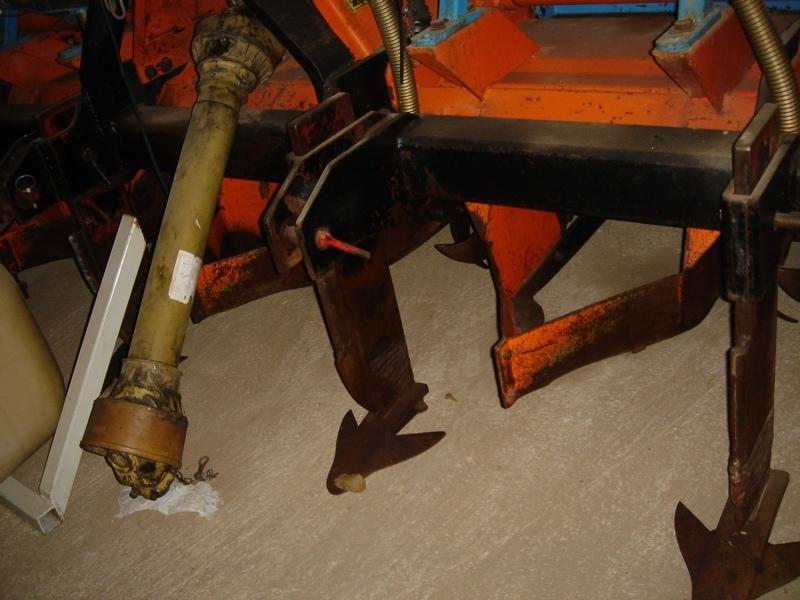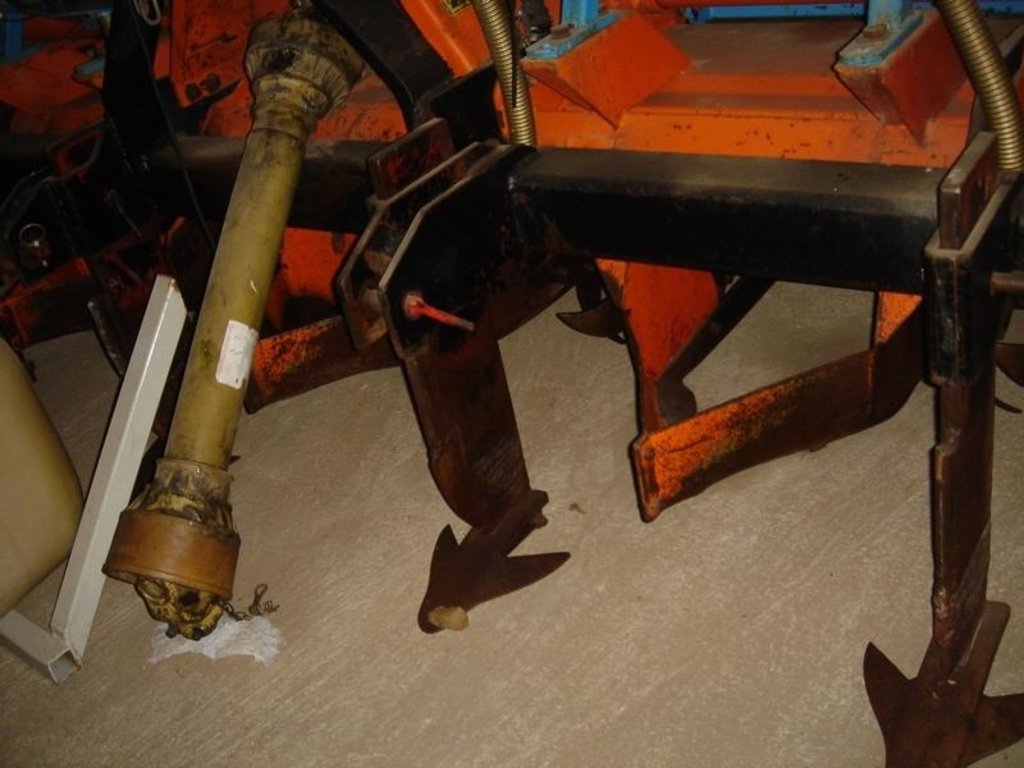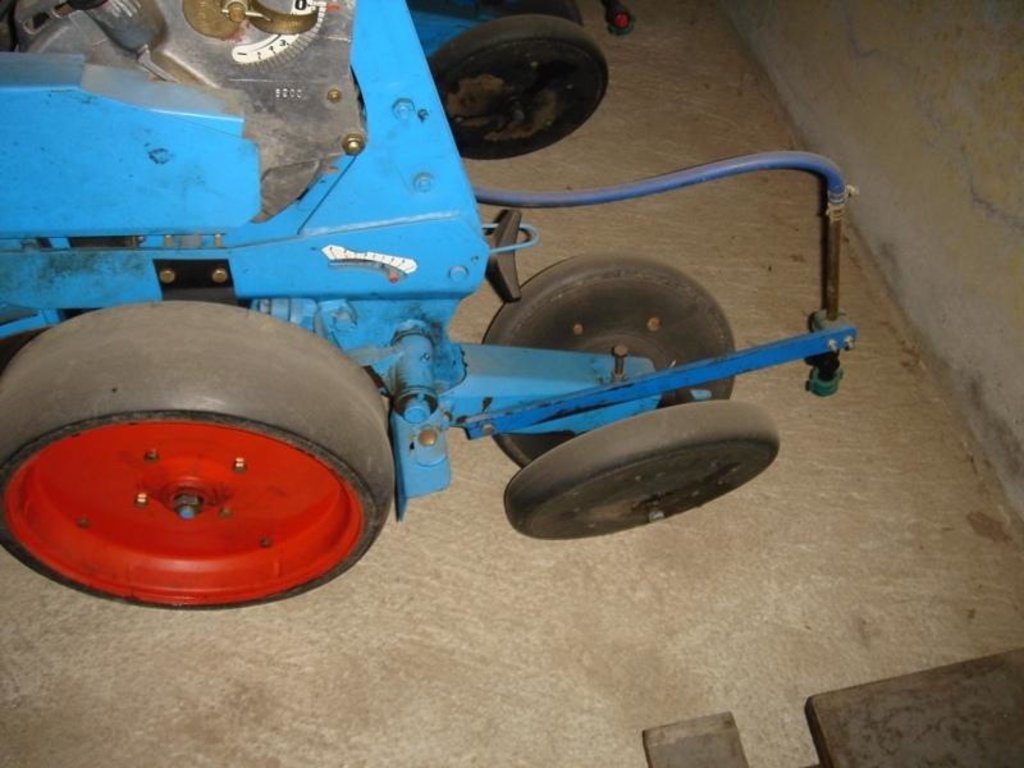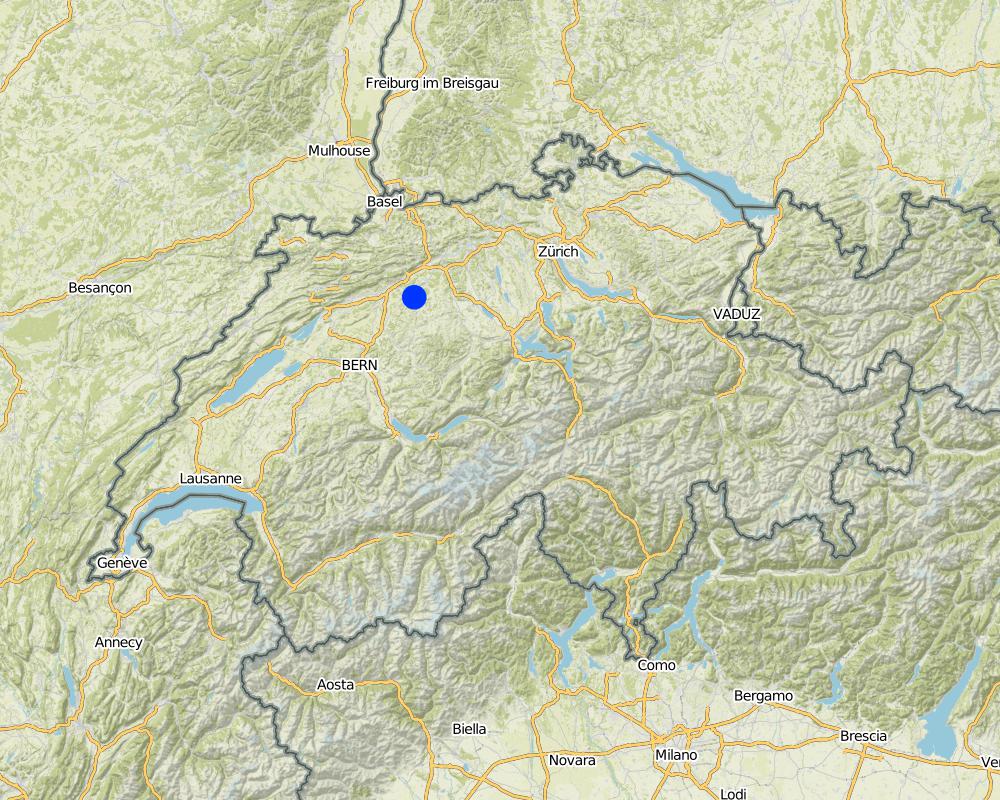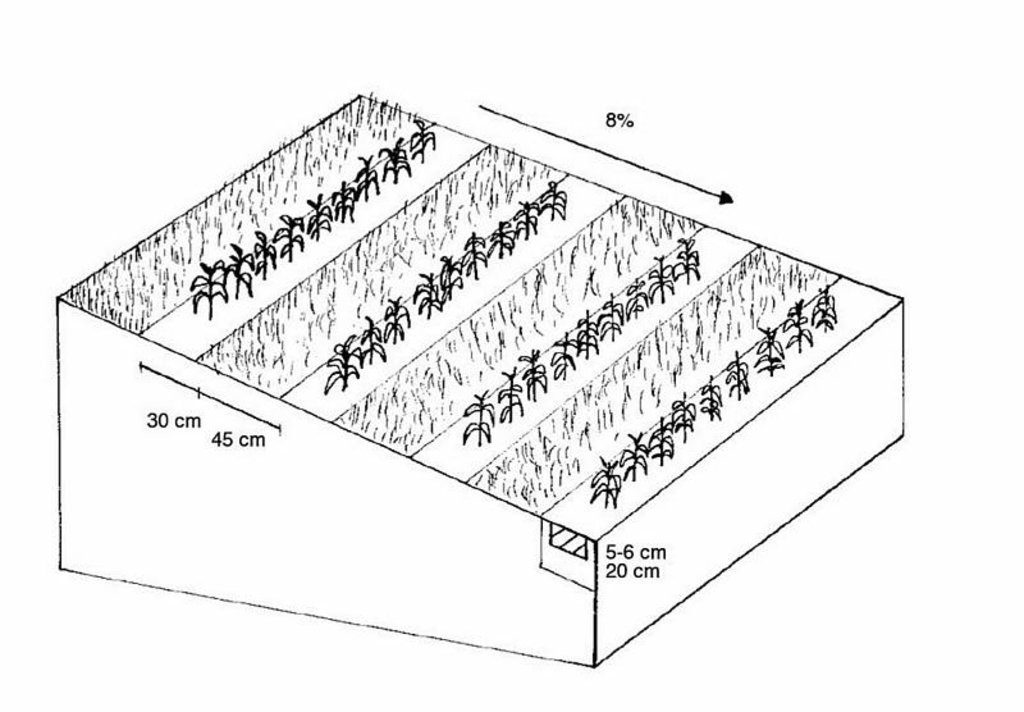Maize strip tillage [Suiza]
- Creación:
- Actualización:
- Compilador: Unknown User
- Editor: –
- Revisores: Fabian Ottiger, Alexandra Gavilano
Streifenfrässaat
technologies_1010 - Suiza
Visualizar secciones
Expandir todo Colapsar todos1. Información general
1.3 Condiciones referidas al uso de datos documentados mediante WOCAT
El compilador y la/s persona(s) de referencia claves aceptan las condiciones acerca del uso de los datos documentados mediante WOCAT:
Sí
2. Descripción de la Tecnología MST
2.1 Breve descripción de la Tecnología
Definición de la Tecnología:
Maize strip tillage is a conservating method for corn production.
2.2 Descripción detallada de la Tecnología
Descripción:
Maize strip tillage is a soil-conserving method used in crop production. First of all the grass in the area needs to be prepared by splattering round-up about 3-10 days prior to sowing.
If the weather conditions are dry enough, a special grubber ('Flügelschargrupper') slacks the soil (20cm), the fertilizer is added in the stripes and afterwards the seed is added. Then the actual maize strip tillage machine carves a stripe and the seed are inserted within this strip of 30 cm. At the same time fertilizer is added on these cultivated stripes. Between those cultivated stripes the mulch-grass stripes (45cm) are unmechanised and protect the soil by increasing its stability. At the end a herbicide is applied on the cultivated strip. All working steps can be done at the same time compared to the traditional technique whereas the farmer needs to drive for each working step separately.
There are some clear economic advantages using this technology. It is less time consuming and the costs for diesel are also lower. On the other hand, by applying maize strip tillage the timing of the cultivation is very important and if the conditions are too wet, it is very likely that a farmer needs more herbicide in order to guarantee an optimal growth period.
However, like in a minimum tillage system there are some ecological advantages like enhancing soil stability. Another advantage is the better soil structure due to the mulch stripes. Due to these mulch-stripes the matrix of the soil is more complex and therefore the stability is better especially during the harvest in September. Soil compaction would occur less and the possibility of soil erosion is decreasing. Especially in hilly areas, as there are many in Switzerland, the technology is suitable since soil erosion is a problem in hilly areas when using a plough.
The interviewed farmer said that the farmers need a sound knowledge about the natural environment. Compared to the traditional technology, the farmers need to observe the corn plants carefully in order to ensure their growth period. Frthermore he said that the farmers need to get used to the sensitivity of this technology. If they are not applying the right amount of herbicide, the probability of getting a smaller harvest is increasing. If springtime is humid, the farmers should be able to use the traditional technology cause this SLM technology is only useful if the conditions are not too humid.
The interviewed farmer said that the economic advantages would be very beneficial to most of the farmers. Although the establishment costs for the machines needed for this technology seem to be high. The farmer can also hire a contractor like him and then he only needs to pay the labour but not the equipment itself. If a farmer wants to apply this technology, the canton of Bern provides them with subsidies during the initial 5 years.
2.3 Fotografías de la Tecnología
2.5 País/ región/ lugares donde la Tecnología fue aplicada y que se hallan comprendidos por esta evaluación
País:
Suiza
Región/ Estado/ Provincia:
Bern
Especifique más el lugar :
Thunstetten
Especifique la difusión de la Tecnología:
- distribuida parejamente sobre un área
Si se desconoce el área precisa, indique el área aproximada cubierta:
- 10-100 km2
Comentarios:
The farmer owns 35 km2 but is applying the technology on 100 km2 in the surrounding area
Map
×2.6 Fecha de la implementación
Si no se conoce el año preciso, indique la fecha aproximada:
- 10-50 años atrás
2.7 Introducción de la Tecnología
Especifique cómo se introdujo la Tecnología:
- durante experimentos/ investigación
Comentarios (tipo de proyecto, etc.):
A decade ago a farmer invented the machine for maize strip tillage and the departmenet for soil conservation promoted this technology afterwards.
3. Clasificación de la Tecnología MST
3.2 Tipo(s) actuales de uso de la tierra donde se aplica la Tecnología

Tierras cultivadas
- Cosecha anual
Cosechas anuales - Especifique cultivos:
- cereales - maíz
Número de temporadas de cultivo por año:
- 1
Especifique:
Longest growing period in days: 150 Longest growing period from month to month: Apr - Sep
Comentarios:
Major land use problems (compiler’s opinion): If a plough is used when having a hillside situation the soil may easily erode.
Major land use problems (land users’ perception): The danger of erosion and soil compaction is accelareted when using a plough in a hillside area.
3.5 Grupo MST al que pertenece la Tecnología
- perturbación mínima del suelo
- medida de pendiente transversal
3.6 Medidas MST que componen la Tecnología

medidas agronómicas
- A3: Tratamiento de superficie del suelo
A3: Diferencie sistemas de labranza:
A 3.2: Reduced tillage (> 30% soil cover)
Comentarios:
Type of agronomic measures: better crop cover, retaining more vegetation cover, mulching, minimum tillage
3.7 Principales tipos de degradación del suelo encarados con la Tecnología

erosión de suelos por agua
- Wt: pérdida de capa arable/ erosión de la superficie
- Wg: erosión en cárcavas

deterioro físico del suelo
- Pc: compactación

degradación biológica
- Bc: reducción de la cobertura vegetal del suelo
Comentarios:
Main type of degradation addressed: Wt: loss of topsoil / surface erosion
Secondary types of degradation addressed: Wg: gully erosion / gullying, Pc: compaction, Bc: reduction of vegetation cover
Main causes of degradation: crop management (annual, perennial, tree/shrub) (using the plough on hillside areas can increase soil erosion)
4. Especificaciones técnicas, actividades de implementación, insumos y costos
4.1 Dibujo técnico de la Tecnología
Especificaciones técnicas (relacionadas al dibujo técnico):
Technical knowledge required for field staff / advisors: high
Technical knowledge required for land users: moderate
Main technical functions: improvement of ground cover
Secondary technical functions: improvement of topsoil structure (compaction), increase in organic matter, increase of infiltration
Minimum tillage
Remarks: only where the crop seeds are inserted
4.2 Información general sobre el cálculo de insumos y costos
otra / moneda nacional (especifique):
Swiss Franc
Si fuera relevante, indique la tasa de cambio de dólares americanos a la moneda local (ej. 1 U$ = 79.9 Reales Brasileros): 1 U$ =:
1,08
Indique el costo promedio del salario de trabajo contratado por día:
194.00
4.3 Actividades de establecimiento
| Actividad | Momento (estación) | |
|---|---|---|
| 1. | Buying machine for stripe mill cropping |
Comentarios:
Life span of the product: 15 years
4.4 Costos e insumos necesarios para el establecimiento
Comentarios:
Duration of establishment phase: 2 month(s)
4.5 Actividades de establecimiento/ recurrentes
| Actividad | Momento/ frequencia | |
|---|---|---|
| 1. | Applying Round-up herbicide on the area | 1 once before corn cultivation |
| 2. | Using of the machine for maize strip tillage, seeding and fertilizing within one workstep | 1 |
| 3. | Appliance for herbicide (Glyphosat) | 1-2 |
| 4. | Harvest of the corn | 1 |
4.6 Costos e insumos necesarios para actividades de mantenimiento/ recurrentes (por año)
Comentarios:
Establishment costs are estimated for the contractor. Labour costs indicated above are the costs which the contractor is demanding for if he is hired. Additionally, those farmers who adapt this technology can get subsidies from the Canton if the farmer commits to apply soil conservation measures during 5 years, in Bern it is 450 CHF per ha.
4.7 Factores más determinantes que afectan los costos:
Describa los factores más determinantes que afectan los costos:
Labour costs might seem high for a farmer if he delegates the establishment to a contractor. In comparison to the traditional cultivation system the contractor would ask about $240 for ploughing , $185 for harrowing , $92 for seeding, $70 for biocide and $46 for fertilizer per ha. Therefore using maize strip tillage is almost a third less expensive than the traditional cultivation. Most of the farmers that hire the contractor are applying the biocides themselves when using maize strip tillage, which makes the costs even lower.
5. Entorno natural y humano
5.1 Clima
Lluvia anual
- < 250 mm
- 251-500 mm
- 501-750 mm
- 751-1,000 mm
- 1,001-1,500 mm
- 1,501-2,000 mm
- 2,001-3,000 mm
- 3,001-4,000 mm
- > 4,000 mm
Especificaciones/ comentarios sobre la cantidad de lluvia:
Average:
850-900 mm for the last 3 years
1200 mm some 10 years ago
Zona agroclimática
- Sub-húmeda
Thermal climate class: temperate
5.2 Topografía
Pendientes en promedio:
- plana (0-2 %)
- ligera (3-5%)
- moderada (6-10%)
- ondulada (11-15%)
- accidentada (16-30%)
- empinada (31-60%)
- muy empinada (>60%)
Formaciones telúricas:
- meseta/ planicies
- cordilleras
- laderas montañosas
- laderas de cerro
- pies de monte
- fondo del valle
Zona altitudinal:
- 0-100 m s.n.m.
- 101-500 m s.n.m.
- 501-1,000 m s.n.m
- 1,001-1,500 m s.n.m
- 1,501-2,000 m s.n.m
- 2,001-2,500 m s.n.m
- 2,501-3,000 m s.n.m
- 3,001-4,000 m s.n.m
- > 4,000 m s.n.m
5.3 Suelos
Profundidad promedio del suelo:
- muy superficial (0-20 cm)
- superficial (21-50 cm)
- moderadamente profunda (51-80 cm)
- profunda (81-120 cm)
- muy profunda (>120 cm)
Textura del suelo (capa arable):
- áspera/ ligera (arenosa)
- mediana (limosa)
Materia orgánica de capa arable:
- media (1-3%)
Si se halla disponible, adjunte una descripción completa de los suelos o especifique la información disponible, por ej., tipo de suelo, pH/ acidez de suelo, capacidad de intercambio catiónico, nitrógeno, salinidad, etc. :
Soil texture is coarse/light (sandy) or medium (loamy, silty) (medium till light soils, depending on the area. On heavy soils technology is not applied).
Soil fertility is medium
Soil drainage/infiltration is good
Soil water storage capacity is medium
5.4 Disponibilidad y calidad de agua
Agua subterránea:
5-50 m
Disponibilidad de aguas superficiales:
bueno
Calidad de agua (sin tratar):
agua potable de buena calidad
Comentarios y especificaciones adicionales sobre calidad y cantidad de agua:
Ground water table: 5-50 m (depending on the area)
Water quality (untreted): Good drinking water (depending on the region)
5.6 Las características de los usuarios de la tierra que aplican la Tecnología
Ingresos no agrarios:
- 10-50% de todo el ingreso
Nivel relativo de riqueza:
- muy rico
Individuos o grupos:
- individual/ doméstico
Indique otras características relevantes de los usuarios de las tierras:
Difference in the involvement of women and men: Usually the women are responsible for the administration and household and the men for the actual work on the fields, assuming that the decision to implement a new technology is made by both.
Population density: < 10 persons/km2
Annual population growth: < 0.5%
(His contract company is relatively large.).
5.8 Tenencia de tierra, uso de tierra y derechos de uso de agua
Tenencia de tierra:
- individual, con título
Derechos de uso de tierra:
- arrendamiento
Derechos de uso de agua:
- comunitarios (organizado)
Comentarios:
The area around the farmer house is individually owned but the surrounding agricutlural land is leased.
5.9 Acceso a servicios e infraestructura
salud:
- pobre
- moderado
- bueno
educación:
- pobre
- moderado
- bueno
asistencia técnica:
- pobre
- moderado
- bueno
empleo (ej. fuera de la granja):
- pobre
- moderado
- bueno
mercados:
- pobre
- moderado
- bueno
energía:
- pobre
- moderado
- bueno
caminos y transporte:
- pobre
- moderado
- bueno
agua potable y saneamiento:
- pobre
- moderado
- bueno
6. Impactos y comentarios para concluir
6.3 Exposición y sensibilidad de la Tecnología al cambio climático gradual y a extremos relacionados al clima/ desastres (desde la percepción de los usuarios de tierras)
Cambio climático gradual
Cambio climático gradual
| Estación | Incremento o reducción | ¿Cómo es que la tecnología soporta esto? | |
|---|---|---|---|
| temperatura anual | incrementó | bien |
Extremos (desastres) relacionados al clima
Desastres climatológicos:
| ¿Cómo es que la tecnología soporta esto? | |
|---|---|
| tormenta de lluvia local | bien |
| tormenta de viento | no se sabe |
Desastres climatológicos
| ¿Cómo es que la tecnología soporta esto? | |
|---|---|
| sequía | bien |
Desastres hidrológicos
| ¿Cómo es que la tecnología soporta esto? | |
|---|---|
| inundación general (río) | no se sabe |
Otras consecuencias relacionadas al clima
Otras consecuencias relacionadas al clima
| ¿Cómo es que la tecnología soporta esto? | |
|---|---|
| periodo reducido de crecimiento | no muy bien |
Comentarios:
With the grass stripes between the corn, the water can infiltrate faster and the soil is more stable and protected. The technology can be more tolerant towards intensive rainfalls but only to a certain moment. The technology is more sensitive towards humid conditions in spring and problems can accure when trying to apply the stripe mill cropping.
6.4 Análisis costo-beneficio
¿Cómo se comparan los beneficios con los costos de establecimiento (desde la perspectiva de los usuarios de tierra)?
Ingresos a corto plazo:
negativo
Ingresos a largo plazo:
positivo
¿Cómo se comparan los beneficios con los costos de mantenimiento/ recurrentes (desde la perspectiva de los usuarios de tierra)?
Ingresos a corto plazo:
ligeramente negativo
Ingresos a largo plazo:
positivo
6.5 Adopción de la Tecnología
Comentarios:
35% of land user families have adopted the Technology with external material support
Comments on acceptance with external material support: If farmers have good experiences more than 80% are maintaining this technology even without external subsidies of the Canton.
There is a moderate trend towards spontaneous adoption of the Technology
Comments on adoption trend: The subsidies from the Canton are very supportive for farmers to implement the new technology
7. Referencias y vínculos
7.1 Métodos/ fuentes de información
Vínculos y módulos
Expandir todo Colapsar todosVínculos
No hay vínculos
Módulos
No se hallaron módulos


